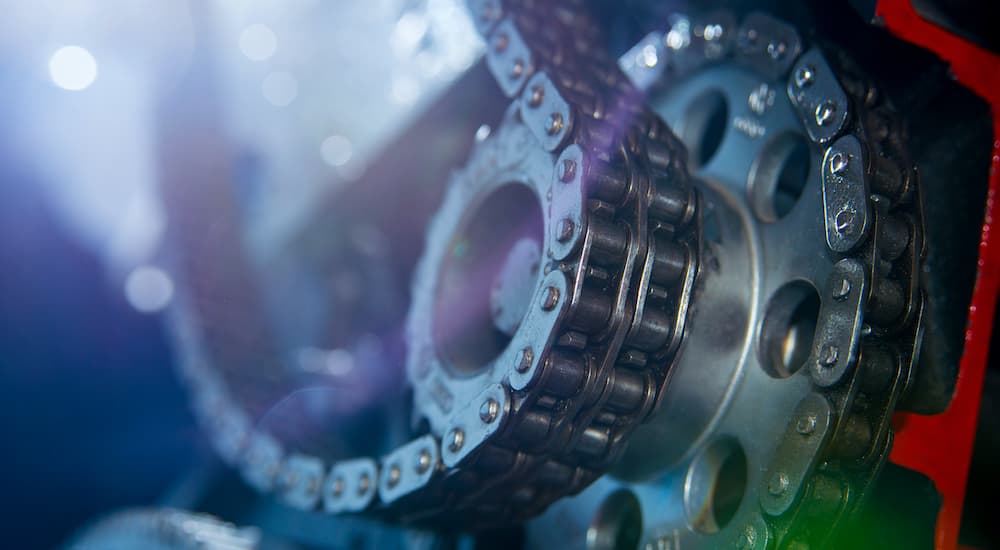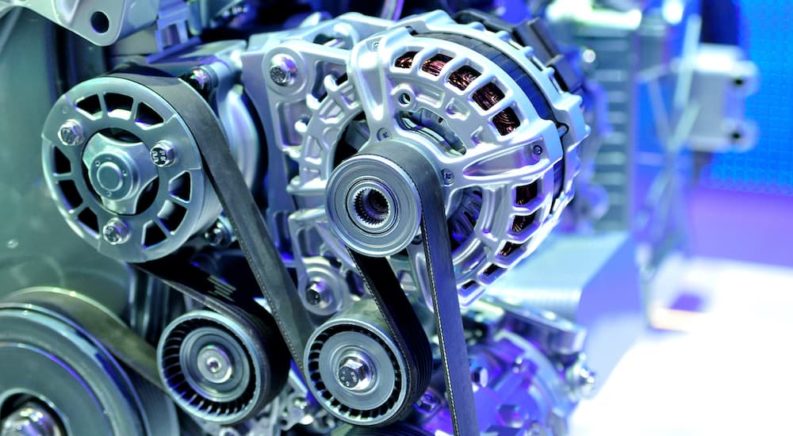Timing belt, serpentine belt, V-belt, fan belt – that’s a lot of different belts to keep straight. And what’s the difference between a timing belt and a timing chain, or are they just two names for the same thing? Well, get ready, because today we are going to explain all those spinning belts under the hood of your car and give you some basic pointers for keeping them in good shape. While dealing with belts and chains may seem like a daunting task at first, maintaining and replacing them is actually a fairly simple DIY job that requires little in the way of specialized tools.
What Is a Belt For? Drive Belts
A car may seem like an almost magical electro-mechanical contraption, but when you start breaking things down, even a modern vehicle becomes surprisingly simple. All of the electronics, climate control, and accessories of your vehicle get their power from the engine. A drive belt is a simple way of tapping power from the engine to operate anything other than the actual powertrain. However, while the concept is simple, there are a couple of different ways to go about it.
Older cars tended to have a variety of drive belts, each powering a specific accessory. This is where you will see things like fan belts, alternator belts, water pump belts, etc. Taken together, all of these belts are commonly referred to as V-belts for the “V” like shape they make between the three points of the crankshaft, accessory, and tensioner. While it may make the engine bay look considerably more complex, using multiple V-belts actually simplifies things in many ways. Since each accessory is powered by a single belt, troubleshooting is more straightforward, and even if one item fails, everything else will keep working.
So why do only older cars use V-belts? Efficiency. Today, car manufacturers work hard to squeeze out every ounce of efficiency possible in order to meet government fuel economy standards. Having a large number of drive belts attached to an engine means more friction and drag, reducing fuel economy. Instead, manufacturers have moved towards using a single serpentine belt that powers all the accessories (although the fans on modern cars are usually electric and no longer connected to a belt) – the name comes from how the belt snakes its way along the face of the engine. A serpentine belt also has the benefit of taking up less space in a cramped engine bay and reducing the number of parts you need to keep track of.
The Second Type of Belt – Timing Belts
However, there is another type of belt in your engine bay that serves a far more important role. Rather than powering accessories, the timing belt is located inside your engine and keeps the timing of the valves in sync with the movement of the pistons (hence the name). While a bad drive belt will certainly cause you problems, a bad timing belt can outright destroy your engine. Needless to say, this is not something that you should neglect.
However, timing belts are again something that is only found on older cars. Modern cars instead use a timing chain. The two devices serve the same purpose and occupy the same place in the engine – the only difference is their construction. While the timing belt is made of rubber, a timing chain is made of metal and resembles a bicycle chain. So why the switch?
As you probably guessed, a metal timing chain is far more durable than a rubber timing belt. Timing belts were primarily used because they were much cheaper and a bit more efficient. They were also primarily used with less capable “non-interference engines” (i.e. an engine where the pistons and valves never occupy the same physical space) where a belt failure would not immediately destroy the engine. The increasing reliability of cars, combined with the switch to more capable “interference engines,” meant that using weaker drive belts was no longer acceptable.

Maintaining Drive Belts
All engine belts are constructed of reinforced rubber, and while they will last for tens of thousands of miles, they are a wear item and do need to be replaced regularly. Fortunately, drive belts are easy to inspect, and you can check their condition any time you pop the hood. There are two main things you want to look for – tension and wear.
Wear is rather self-explanatory. If you notice that one of the drive belts in your car is torn, frayed, missing teeth, or has other obvious damage, then it is time to replace it. If you aren’t well on your way to 100,000 miles or the damage does not appear to be natural wear, then you probably also want to check to see if the belt is rubbing against something in the engine bay that is causing the damage.
Tension is a bit less obvious. While most belts have teeth on them, they rely on the friction from proper tension to work properly. V-belts and serpentine belts will both generally have an adjustable pulley known as the tensioner that exists solely to keep the belt at the proper level of tension. If the belt stretches or the tensioner is loose, the belt will begin slipping, and anything that it is powering will stop working properly. Many modern cars have tensioners that will automatically adjust to maintain proper tension even as the belt stretches over time, but these can introduce their own set of issues.
Every car will have its own specific details of how to check for proper drive belt tension and adjust the tensioner. However, you can perform a basic belt tension check even if you don’t have all the specialist tools many cars call for. All belts should have some play in them, but a good rule of thumb is that if you can rotate a drive belt more than 90 degrees by hand, it is probably loose. If you have a loose belt, always inspect the tensioner as well, but the odds are the belt is simply old and needs to be replaced.

Maintaining Timing Belts and Chains
While drive belts are easy to inspect, timing belts are not. Accessing them usually involves pulling off all the drive belts and then removing the timing case that covers the front of the engine. If you aren’t comfortable working on the engine, then you will want to leave this to the pros, but an engine is generally fairly simple to work on, and this is not a particularly difficult DIY on most cars.
Because the timing belt is difficult to get to, it is not something that is commonly checked. Instead, it is something that should be replaced on a set schedule – generally somewhere between 50,000 and 100,000 miles depending on the car. Because of the critical role played by the timing belt, this is not a maintenance item that should ever be put off or neglected – especially if you have an interference engine with a timing belt. Always replace the belt on schedule, even if it does not appear to be worn or stretched.
Timing chains are far more durable than timing belts and are usually designed to last for the lifetime of the engine without maintenance or replacement. However, the engineers don’t always get things right, and hard use or lack of maintenance can accelerate timing chain wear. If you suspect a failing timing chain, get the vehicle inspected immediately, as a catastrophic failure will destroy your engine. The timing chain tensioner is also a potential point of failure, even if the timing chain itself is in good condition.
Regular Inspections Are Key
Even if you don’t feel up to the task of replacing drive belts or timing belts in your driveway, inspecting drive belts is an easy way to keep an eye on your car’s condition and have a better idea of what is going on under the hood. Being able to identify a loose or worn drive belt before it starts causing problems can save you a lot of hassle and allow you to spend less time and money at the mechanic while they troubleshoot your car. So don’t be afraid of that spinning mass of rubber in the engine bay – it’s a simple system that anyone can understand.

